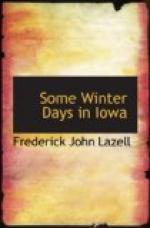The frequent rambler through the winter woods can scarcely fail to become acquainted with all the winter birds. The different species are not numerous, few of them are very shy, they are easily seen because of the bare trees, and their habits tend to call attention to them; especially is this true of the woodpeckers. It is true, of course, that one may sometimes walk in the woods for hours, scarcely seeing a single bird. But it is also true that if he starts out some sunny morning, and seeks a tract of heavy timber near a river, he will be very likely to see and hear nearly all of them.
Such a ramble was enjoyed during the halcyon days we had this year (1907) in February. By 10 o’clock the woods were fairly ringing with bird-calls. Over a meadow, near the entrance to the woods, a red-tailed hawk was circling about twenty-five feet from the ground, as if in search of meadow mice. The field glass showed the black band on his breast and tail, which, with his bright red tail, sufficiently established his identity.
The first bird seen in the woods was a white-breasted nuthatch, working on the trunk of a red birch on the river bottom. Next to the chickadee, he is the tamest bird of the woodlands. One may easily get within six feet of him, as was done on this occasion, and admire his beautiful ashy-blue coat, his white vest and white cheeks, with his black cap and nape. He pulled a fat white grub from the birch with his long, slender bill and ate it with evident relish. Then he uttered his soft “quank, quank” and gently flew to another tree.
Sometimes these “quank, quanks” come in a loud and rapid series and may easily be heard a quarter of a mile on a still day.
A flock of juncos were busy among the dead leaves and the snow. They are sparrow-size, like the nuthatch, and their faint chirpings are much like those of the chickadee. The slate gray of their head, throat, back and breast is an interesting color, and is relieved from somberness by the white under parts and the yellow bills. The white outer tailfeathers show plainly as they fly. They frequent the road through the timber and have some of the habits of the English sparrow. The winter woods would miss them.
Chickadees were busy in the birches. Surely the chickadee is one of the dearest little fellows that fly. He has four modes of expression:
1. The well-known “Chick-a-dee-dee-dee.”
2. The “pe-ho,” which ought to be written “la sol,” pitched at about upper D and C, above the soprano staff, and timed like two quarter notes.
3. The faint chirpings as he works.
4. A happy little gurgling song, which can hardly be translated into words.
The chickadee wears a black cap with a white vest and a blue-gray coat, completing his costume with a black necktie, and he is perfectly willing to sit for you and have his picture taken.




